Evaluation of Electric Field and Space Charge Dynamics in Dielectric under DC Voltage with Superimposed Switching Impulse
Abstract
:1. Introduction
2. Mechanism of Bipolar Charge Transport Model
- Under practical conditions, dielectric material is not homogenous, and local conditions can affect the transport processes and result in localized accumulations of space charge [8].
- It cannot account for the complicated charge transport mechanisms, including charge injection at the electrode, conduction, trapping, detrapping, and recombination in bulk of dielectrics [9].
3. Application of Bipolar Charge Transport Model to Switching Impulse Superimposed on Prestressed DC Voltage
3.1. Governing Equations
3.2. Simulation Conditions
3.3. Simulation Method Based on Coupling of Multisystems
- Each system should be properly configured according to different independent voltage sources. In particular, the system dealing with switching impulse should have much narrower time scale than the other system due to very short duration.
- For accurate and proper coupling, strict time steps should be taken by the solver. Also, multisystems have to solve the coupled physical model for the point where the switching impulse is superimposed on the DC voltage because they have independent voltage sources (i.e., constant DC voltage and switching impulse).
- At the same time, the various continuities for the two phenomena should be taken into consideration. Most importantly, all initial values of the system that deals with the switching impulse should be the same as those under the DC steady state.
4. Simulation Results and Discussions
4.1. Space Charge Behavior under DC Stress Only
- Loss mainly occurred in both mobile electrons and holes.
- The loss of mobile electrons occurred widely within the LDPE, while that of mobile holes occurred only near the anode, which is the injection electrode.
- The rate of loss of mobile holes is relatively high compared to that of mobile electrons.
- Both trapped electrons and holes were mainly generated, in contrast to the mobile carriers.
- The generation of trapped electrons occurred throughout the LDPE, whereas that of trapped holes occurred only near the anode, the injection electrode of holes.
- The rate of generation of trapped holes is relatively high compared to that of trapped electrons.
- As the temperature increases, the effective mobility also increases, so the rate of generation and loss is less localized at higher temperature condition compared to that at room temperature, especially in holes. It could be confirmed by the fact that the trapped holes near the anode shown in Figure 4b and Figure 5b are relatively less localized than those at room temperature. This is due to higher mobility.
- However, the overall rate has increased significantly, resulting in more vigorous generation and loss under high temperature conditions. This is closely related to space charge dynamics, and it can lead to the further distortion of electric field distribution.
4.2. Space Charge Behavior under Switching Impulse Superimposed on Prestressed DC Voltage
4.3. The Effect of Superposition on Electric Field Distribution
5. Conclusions
- In the case of application of HVDC voltage, the increase in charge accumulation was higher at high temperatures.
- Trapped carriers and holes rather than mobile carriers and electrons are more significant in determining the space charge behaviors.
- The switching impulse had no influence on space charge distribution. Because of its momentary nature, switching impulse does not influence the charge transport process.
- However, a superimposed switching impulse raised the maximum electric field intensity by up to 87.7% compared to the DC steady state.
Author Contributions
Funding
Acknowledgments
Conflicts of Interest
References
- Wang, H.T.; Cao, J.Z.; He, Z.Y.; Yang, J.; Han, Z.Y.; Chen, G. Research on Overvoltage for XLPE Cable in a Modular Multilevel Converter HVDC Transmission System. IEEE Trans. Power Deliv. 2016, 31, 683–692. [Google Scholar] [CrossRef]
- CIGRE, T. Recommendations for testing DC extruded cable systems for power transmission at a rated voltage up to 500 kV. 2012. Available online: https://e-cigre.org/publication/496-recommendations-for-testing-dc-extruded-cable-systems-for-power-transmission-at-a-rated-voltage-up-to-500-kv---------this-tb-replaces-tb-219 (accessed on 14 May 2019).
- Current, H.V.D. Power Transmission–Cables with Extruded Insulation and Their Accessories for Rated Voltages up to 320 kV for Land Applications–Test Methods and Requirements. Comitte Draft, CD IEC 2014, 62895. Available online: https://webstore.iec.ch/publication/34020 (accessed on 14 May 2019).
- Zhou, C.; Chen, G. Space charge behaviours in polyethylene under combined AC and DC electric fields. In Proceedings of the 2014 IEEE Conference on Electrical Insulation and Dielectric Phenomena (CEIDP), Des Moines, IA, USA, 19–22 October 2014; pp. 848–851. [Google Scholar]
- Le Roy, S.; Segur, P.; Teyssedre, G.; Laurent, C. Description of bipolar charge transport in polyethylene using a fluid model with a constant mobility: Model prediction. J. Phys. D Appl. Phys. 2004, 37, 298–305. [Google Scholar] [CrossRef]
- Neyts, K.; Karvar, M.; Drobchak, O.; Brans, T.; Strubbe, F.; Beunis, F. Simulation of charge transport and steady state in non-polar media between planar electrodes with insulating layers. Colloid Surface A 2014, 440, 101–109. [Google Scholar] [CrossRef]
- Banda, M.; Griseri, V.; Teyssedre, G.; Le Roy, S. Modelling Charge Generation and Transport in Low Density Polyethylene Irradiated by an Electron-Beam. In Proceedings of the 2018 IEEE 2nd International Conference on Dielectrics (ICD), Budapest, Hungary, 1–5 July 2018; pp. 1–4. [Google Scholar]
- Min, D.M.; Li, S.T. A Comparison of Numerical Methods for Charge Transport Simulation in Insulating Materials. IEEE Trans. Dielectr. Electr. Insul. 2013, 20, 955–964. [Google Scholar] [CrossRef]
- Belgaroui, E.; Boukhris, I.; Kallel, A.; Teyssedre, G.; Laurent, C. A new numerical model applied to bipolar charge transport, trapping and recombination under low and high dc voltages. J. Phys. D Appl. Phys. 2007, 40, 6760–6767. [Google Scholar] [CrossRef]
- Teyssedre, G.; Laurent, C. Charge transport modeling in insulating polymers: From molecular to macroscopic scale. IEEE Trans. Dielectr. Electr. Insul. 2005, 12, 857–875. [Google Scholar] [CrossRef]
- Baudoin, F.; Le Roy, S.; Teyssedre, G.; Laurent, C. Bipolar charge transport model with trapping and recombination: An analysis of the current versus applied electric field characteristic in steady state conditions. J. Phys. D Appl. Phys. 2008, 41. [Google Scholar] [CrossRef]
- Poplavskyy, D.; Su, W.C.; So, F. Bipolar charge transport, injection, and trapping studies in a model green-emitting polyfluorene copolymer. J. Appl. Phys. 2005, 98. [Google Scholar] [CrossRef]
- Hoang, A.T.; Serdyuk, Y.V.; Gubanski, S.M. Charge Transport in LDPE Nanocomposites Part II-Computational Approach. Polymers 2016, 8, 103. [Google Scholar] [CrossRef] [PubMed]
- Hoang, A.T.; Pallon, L.; Liu, D.M.; Serdyuk, Y.V.; Gubanski, S.M.; Gedde, U.W. Charge Transport in LDPE Nanocomposites Part I-Experimental Approach. Polymers 2016, 8, 87. [Google Scholar] [CrossRef] [PubMed]
- Toomer, R.; Lewis, T.J. Charge Trapping in Corona-Charged Polyethylene Films. J. Phys. D Appl. Phys. 1980, 13, 1343–1356. [Google Scholar] [CrossRef]
- Chen, G.; Tay, T.Y.G.; Davies, A.E.; Tanaka, Y.; Takada, T. Electrodes and charge injection in low-density polyethylene—Using the pulsed electroacoustic technique. IEEE Trans. Dielectr. Electr. Insul. 2001, 8, 867–873. [Google Scholar] [CrossRef]
- Fischer, P.; Rohl, P. Thermally Stimulated and Isothermal Depolarization Currents in Low-Density Polyethylene. J. Polym. Sci. Pol. Phys. 1976, 14, 531–542. [Google Scholar] [CrossRef]
- Mizutani, T.; Suzuoki, Y.; Ieda, M. Thermally Stimulated Currents in Polyethylene and Ethylene-Vinyl-Acetate Copolymers. J. Appl. Phys. 1977, 48, 2408–2413. [Google Scholar] [CrossRef]
- Tian, F.Q.; Lei, Q.Q.; Wang, X.; Wang, Y. Effect of deep trapping states on space charge suppression in polyethylene/ZnO nanocomposite. Appl. Phys. Lett. 2011, 99. [Google Scholar] [CrossRef]
- Le Roy, S.; Teyssedre, G.; Laurent, C.; Montanari, G.C.; Palmieri, F. Description of charge transport in polyethylene using a fluid model with a constant mobility: Fitting model and experiments. J. Phys. D Appl. Phys. 2006, 39, 1427–1436. [Google Scholar] [CrossRef]
- Liu, N.; He, M.; Alghamdi, H.; Chen, G.; Fu, M.L.; Li, R.H.; Hou, S. An improved model to estimate trapping parameters in polymeric materials and its application on normal and aged low-density polyethylenes. J. Appl. Phys. 2015, 118. [Google Scholar] [CrossRef]
- Han, B.; Wang, X.; Sun, Z.; Yang, J.M.; Lei, Q.Q. Space charge suppression induced by deep traps in polyethylene/zeolite nanocomposite. Appl. Phys. Lett. 2013, 102. [Google Scholar] [CrossRef]
- Khalil, M.S.; Hansen, B.S. Investigation of Space-Charge in Low-Density Polyethylene Using a Field Probe Technique. IEEE Trans. Dielectr. Electr. Insul. 1988, 23, 441–445. [Google Scholar] [CrossRef]
- Jeroense, M.J.P.; Morshuis, P.H.F. Electric fields in HVDC paper-insulated cables. IEEE Trans. Dielectr. Electr. Insul. 1998, 5, 225–236. [Google Scholar] [CrossRef] [Green Version]

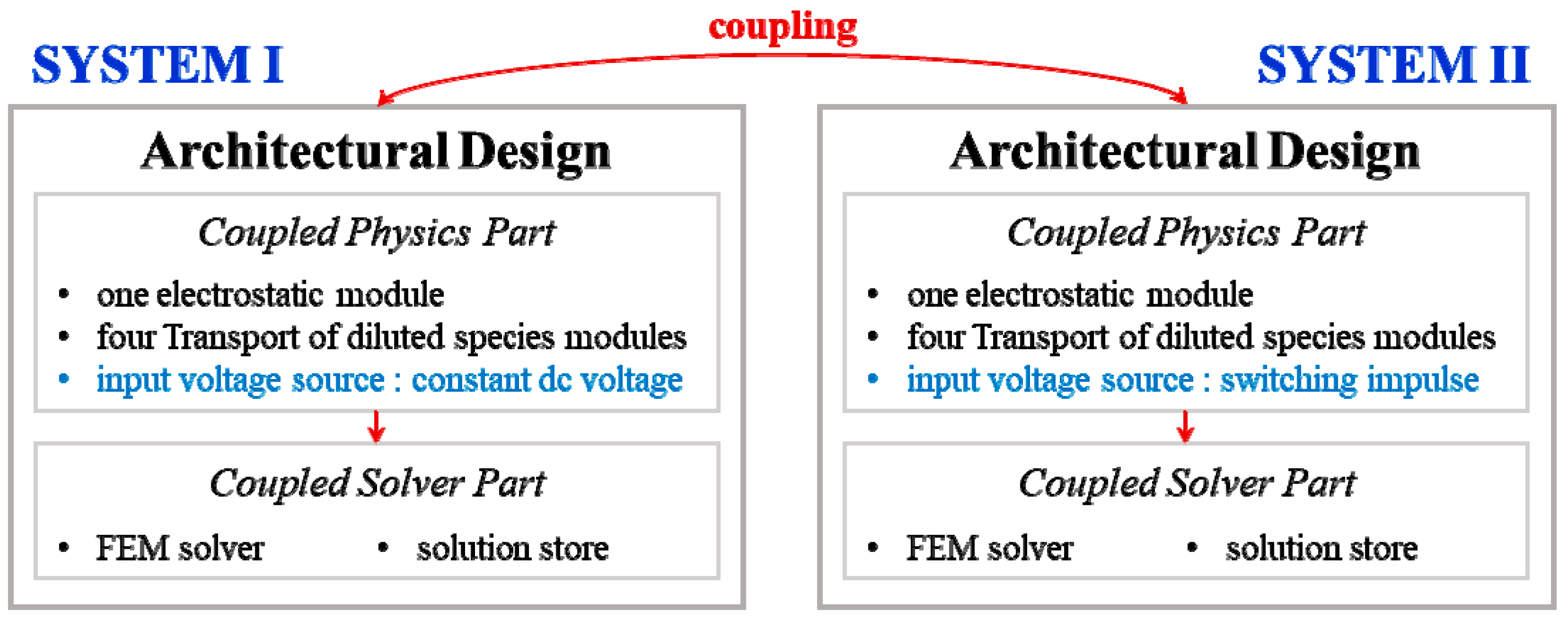
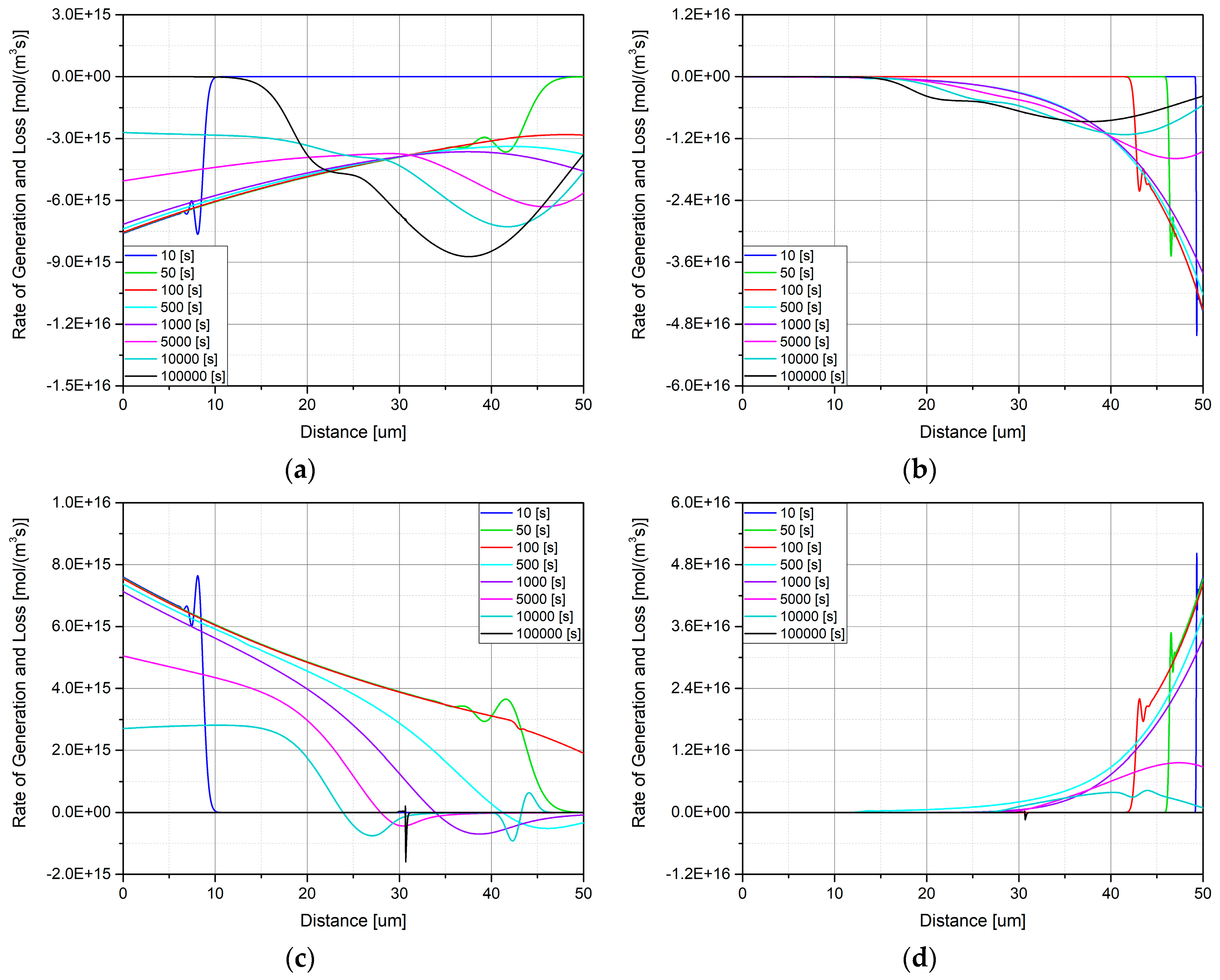
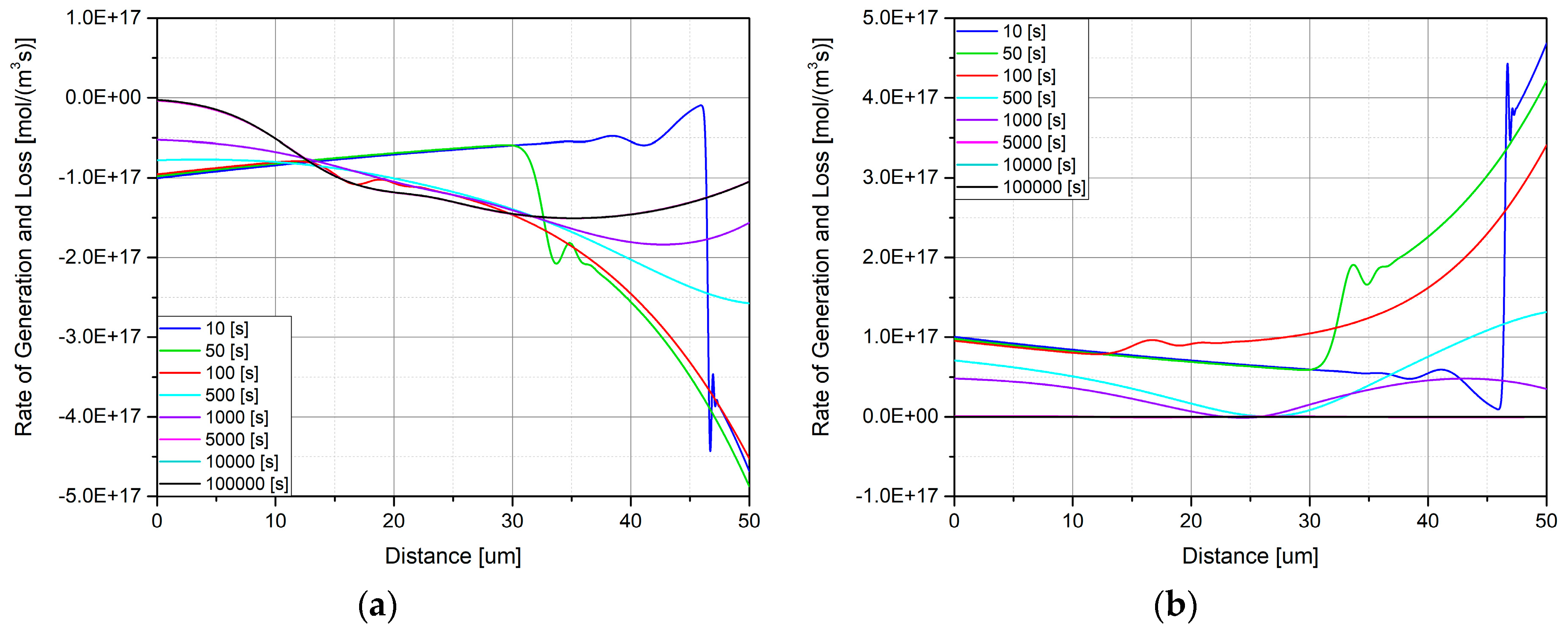
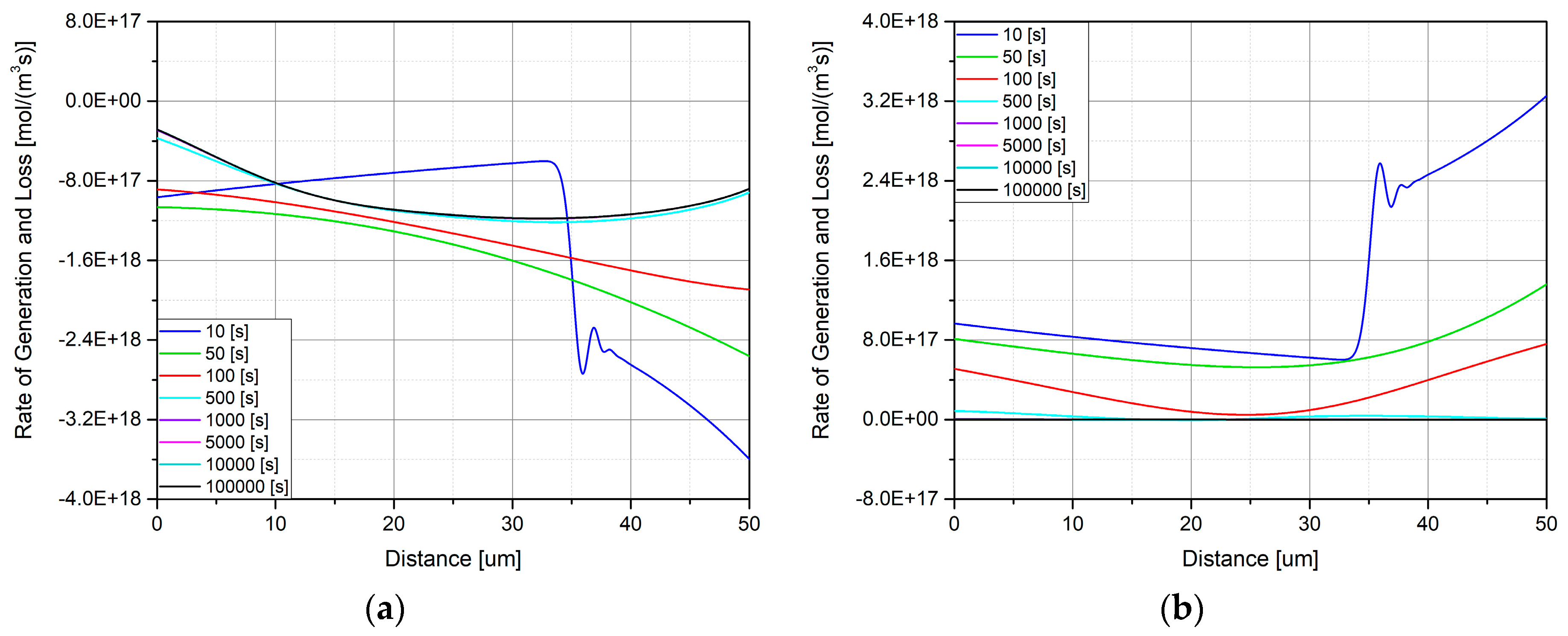
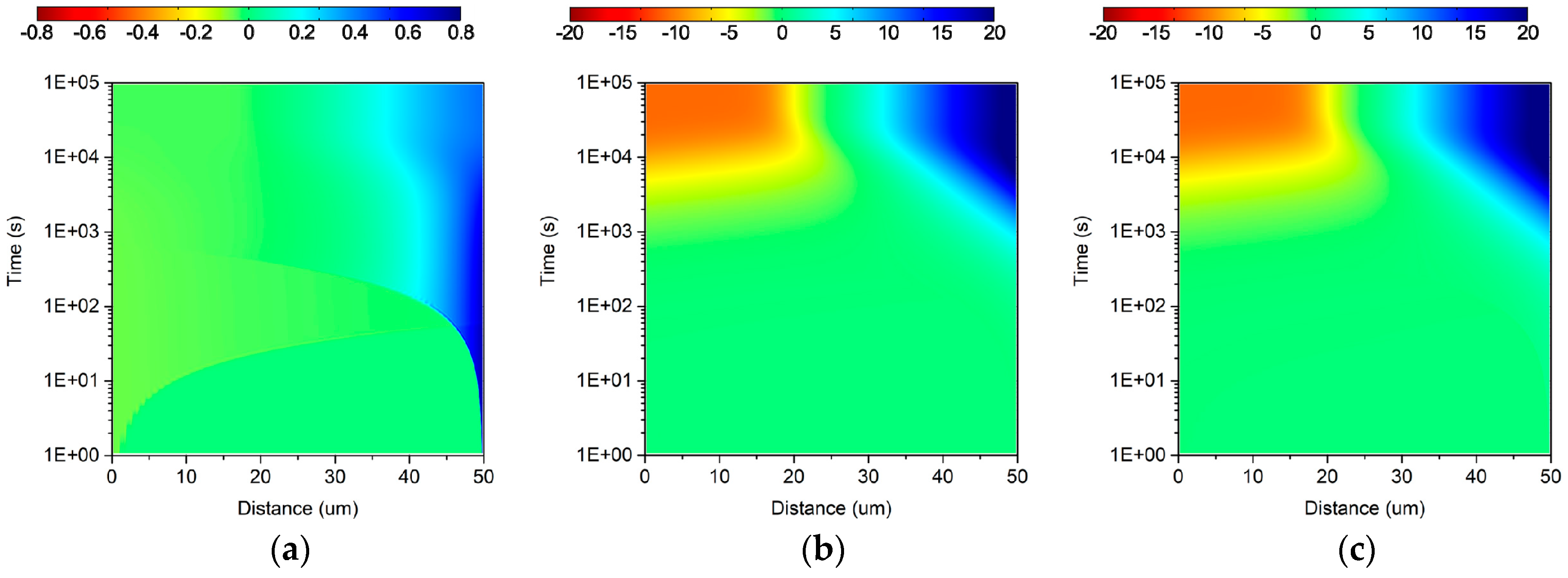

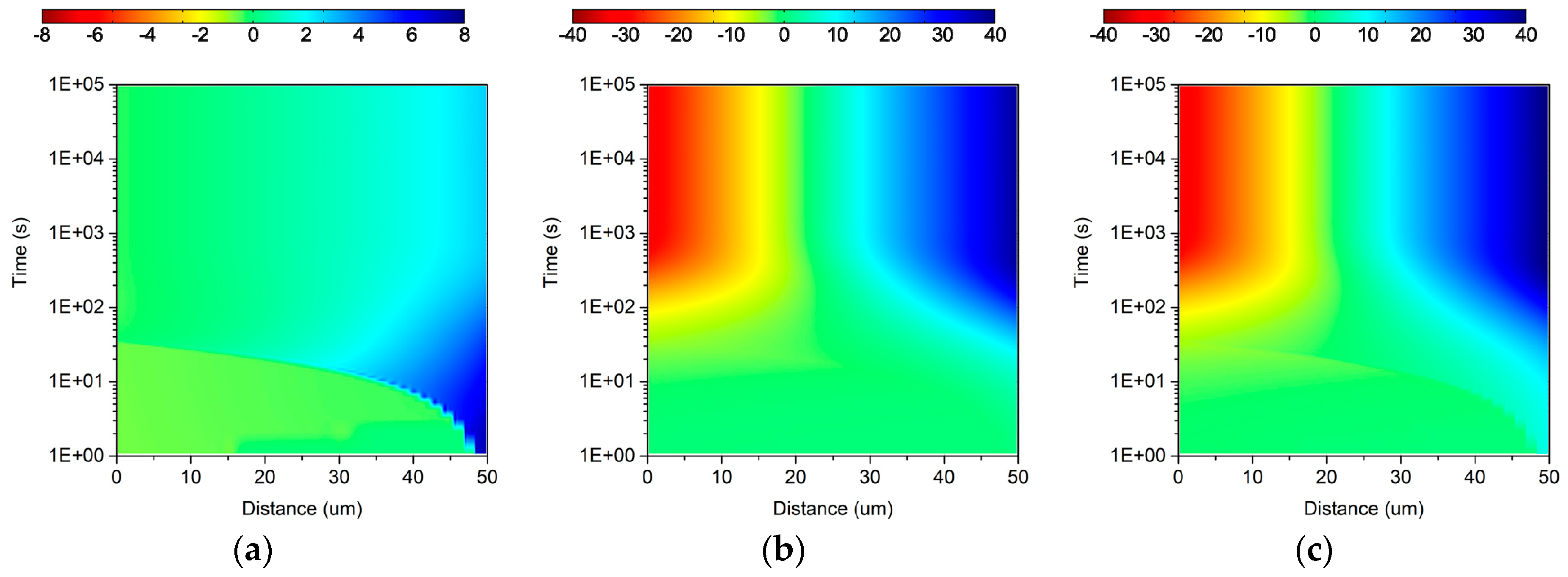
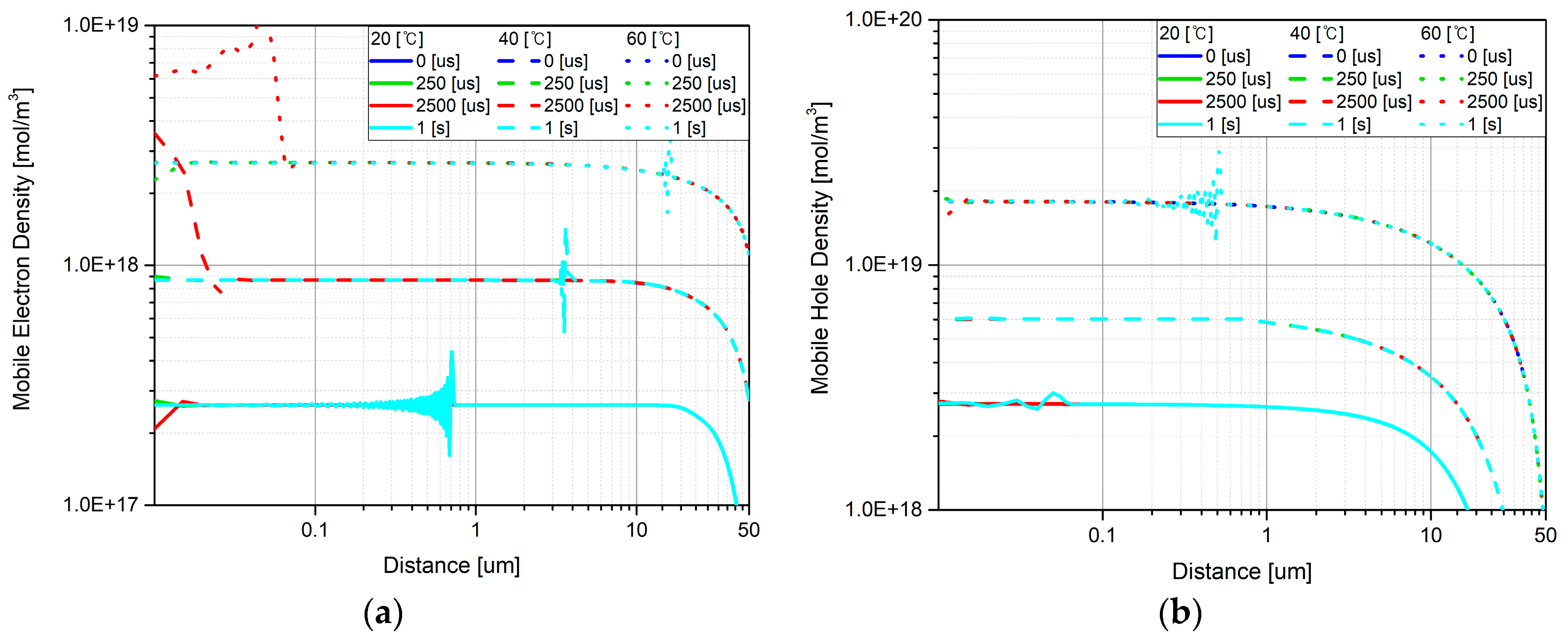
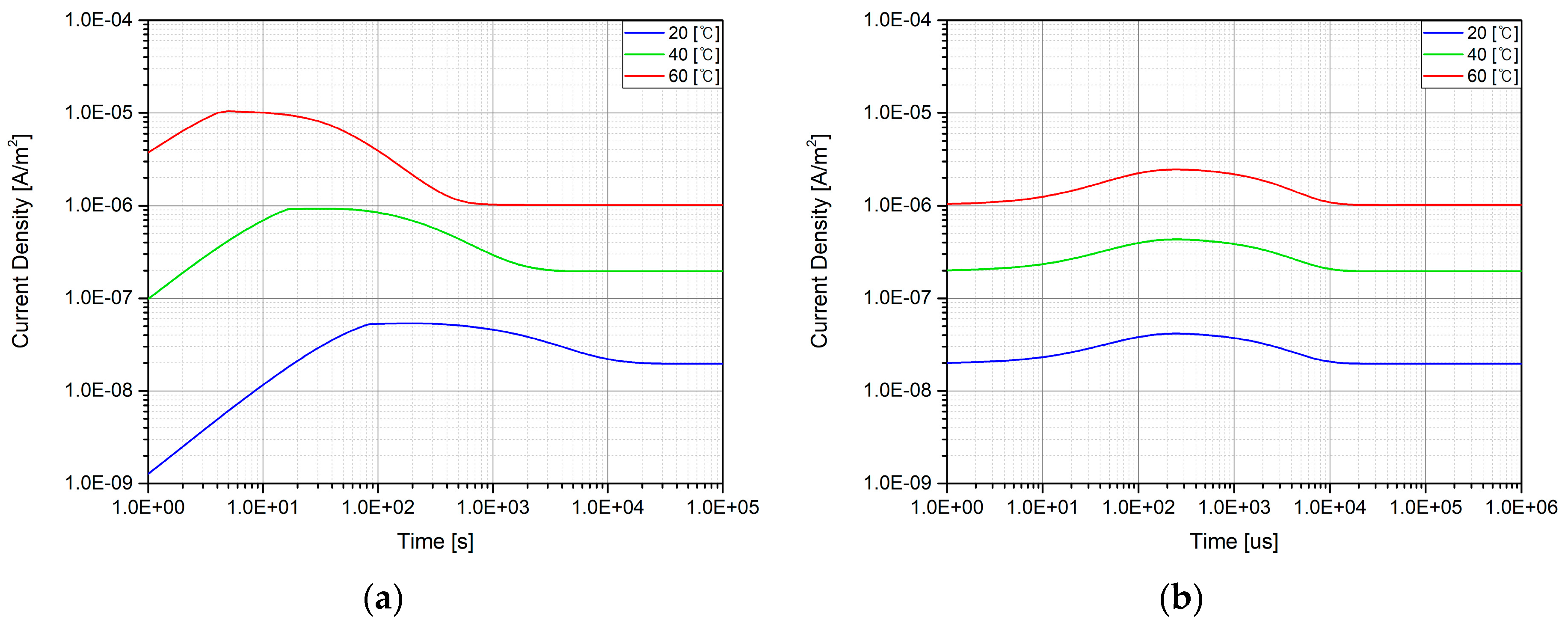


| Parameters | Symbols | Units | Temperature (°C) | ||
|---|---|---|---|---|---|
| 20 | Parameters | Symbols | |||
| Effective Mobility | μe | m2/(V·s) | 3.0 × 10−14 | 1.5 × 10−13 | 5.5 × 10−13 |
| μh | 2.5 × 10−15 | 1.2 × 10−14 | 5.0 × 10−14 | ||
| Trapping Coefficients | te | 1/s | 0.02 | 0.08 | 0.25 |
| th | 0.01 | 0.03 | 0.08 | ||
| Detrapping Barrier Height | wtre | eV | 0.93 | 0.96 | 1.00 |
| wtrh | 0.93 | 0.96 | 1.00 | ||
| Deep Trap Density | Netr | C/m3 | 100 | 100 | 100 |
| Nhtr | 100 | 100 | 100 | ||
| Recombination Coefficients | Reh | m3/s | 0 | 0 | 0 |
| Rehtr | 6.4 × 10−22 | 6.4 × 10−22 | 6.4 × 10−22 | ||
| Retrh | 6.4 × 10−22 | 6.4 × 10−22 | 6.4 × 10−22 | ||
| Retrhtr | 6.4 × 10−22 | 6.4 × 10−22 | 6.4 × 10−22 | ||
| Relative Permittivity | εr | 1 | 2.3 | 2.3 | 2.3 |
| Schottky Injection Barrier Height | wei | eV | 1.20 | 1.20 | 1.20 |
| whi | 1.20 | 1.20 | 1.20 | ||
| Rate | Mobile Carriers | Trapped Carriers |
|---|---|---|
| Generation | Detrapping | Trapping |
| Loss | Trapping, recombination | Detrapping, recombination |
| Electric Field Intensity | Unit | Temperature (°C) | ||
|---|---|---|---|---|
| 20 | 40 | 60 | ||
| EINITIAL | kV/mm | 30.0 | 30.0 | 30.0 |
| EDC.MAX | kV/mm | 34.2 | 35.9 | 37.9 |
| EDC.MAX+SI | kV/mm | 64.2 | 65.9 | 67.9 |
| Increased % of EDC.MAX compared to EINITIAL | % | 14.0 | 19.7 | 26.3 |
| Increased % of EDC.MAX+SI compared to EDC.MAX | % | 87.7 | 83.6 | 79.2 |
© 2019 by the authors. Licensee MDPI, Basel, Switzerland. This article is an open access article distributed under the terms and conditions of the Creative Commons Attribution (CC BY) license (http://creativecommons.org/licenses/by/4.0/).
Share and Cite
Kwon, I.-S.; Kim, S.-J.; Asif, M.; Lee, B.-W. Evaluation of Electric Field and Space Charge Dynamics in Dielectric under DC Voltage with Superimposed Switching Impulse. Energies 2019, 12, 1836. https://doi.org/10.3390/en12101836
Kwon I-S, Kim S-J, Asif M, Lee B-W. Evaluation of Electric Field and Space Charge Dynamics in Dielectric under DC Voltage with Superimposed Switching Impulse. Energies. 2019; 12(10):1836. https://doi.org/10.3390/en12101836
Chicago/Turabian StyleKwon, Ik-Soo, Sun-Jin Kim, Mansoor Asif, and Bang-Wook Lee. 2019. "Evaluation of Electric Field and Space Charge Dynamics in Dielectric under DC Voltage with Superimposed Switching Impulse" Energies 12, no. 10: 1836. https://doi.org/10.3390/en12101836





